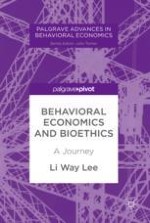2018 | OriginalPaper | Buchkapitel
3. The Two Selves in My Friend Addict
verfasst von : Li Way Lee
Erschienen in: Behavioral Economics and Bioethics
Aktivieren Sie unsere intelligente Suche, um passende Fachinhalte oder Patente zu finden.
Wählen Sie Textabschnitte aus um mit Künstlicher Intelligenz passenden Patente zu finden. powered by
Markieren Sie Textabschnitte, um KI-gestützt weitere passende Inhalte zu finden. powered by
